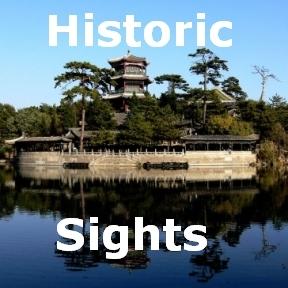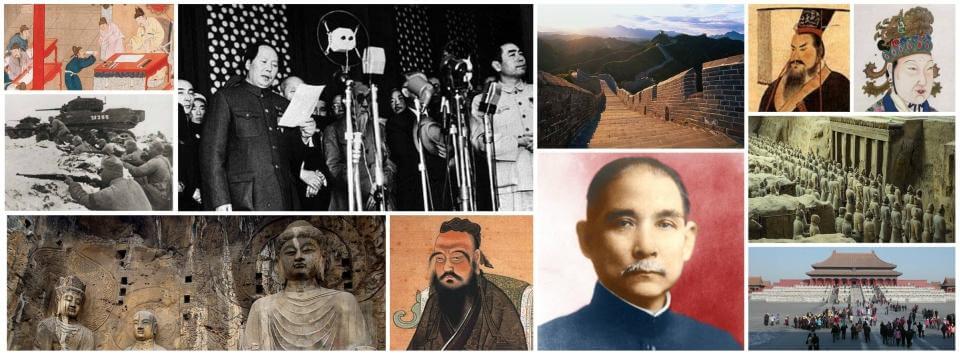
Mogao Caves
The information contained here are subject to change. Chinese History Digest is not responsible or liable if any changes should occur. If you can read Chinese, you can also visit the official website of the Mogao Grottoes for the latest information.
Opening Hours
May - October: 8am - 6pm
November - April: 9am - 5.30pm
Entrance Ticket Prices
April - November: 258 yuan*
December - March: 160 yuan*
* includes Digital Exhibition Center, shuttle bus, museums and guided cave tour
The Mogao Caves are a UNESCO World Heritage site that is located about 25km southeast of the center of Dunhuang in China's northwestern Gansu province. The town of Dunhuang is located in an oasis in the Gobi desert and was once an important hub along the trade route of the ancient Silk Road. The Mogao Caves are widely considered to be the world's most famous Buddhist cave complex and are also known by a variety of other names such as Mogao Grottoes, Caves of the Thousand Buddhas, Thousand Buddha Grottoes and Dunhuang Caves. The latter term is also used as a collective term for all Buddhist cave sites in the Dunhuang area which also include the Western Thousand Buddha Caves, Eastern Thousand Buddha Caves, Yulin Caves and Five Temple Caves.
The Mogao Caves are a veritable treasure trove of Buddhist art that is only rivalled in importance by two other Buddhist cave complexes in China, the Yungang Caves near Datong (Shanxi province) as well as the Longmen Grottoes near Luoyang (Henan province). All three Buddhist cave complexes provide valuable insights into Chinese history and are must-sees on a dedicated sightseeing trip through China, not only for history buffs but also for art lovers.
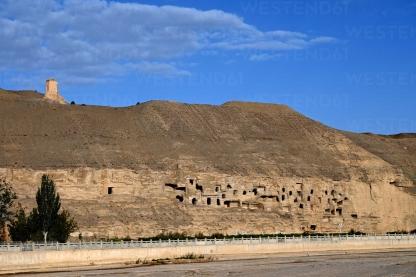 view of the northern section of the Mogao Grottoes from a distanceConstruction of the Mogao Caves began in AD 366 during the period of the Six Dynasties and continued for about 1000 years. A total of 735 of all the caves that were cut into the cliffside of a mountain during this time have survived until today. To be precise, 487 of these caves are located along a 2km stretch at the southern section of the mountain whereas the remaining 248 caves are located to the north from there. Up to 50 of the caves in the south that once served as places of pilgrimage and worship are visitable. The caves in the north once served as living quarters, meditation chambers and burial sites for the resident monks and these northern caves have not been made accessible for tourists so far.
view of the northern section of the Mogao Grottoes from a distanceConstruction of the Mogao Caves began in AD 366 during the period of the Six Dynasties and continued for about 1000 years. A total of 735 of all the caves that were cut into the cliffside of a mountain during this time have survived until today. To be precise, 487 of these caves are located along a 2km stretch at the southern section of the mountain whereas the remaining 248 caves are located to the north from there. Up to 50 of the caves in the south that once served as places of pilgrimage and worship are visitable. The caves in the north once served as living quarters, meditation chambers and burial sites for the resident monks and these northern caves have not been made accessible for tourists so far.
Dunhuang was founded as a frontier garrison outpost in 111 BC during the time of the Han dynasty. In the centuries that followed, this remote outpost became an important hub along the trade route of the ancient Silk Road. According to legend, it was in AD 366 that a Buddhist monk had a vision of a thousand Buddhas bathed in golden light at the site which inspired him to start building the first cave there. More and more monks then came to the area and cave construction accelerated as the community of resident monks grew. The most active period of construction was during the Sui dynasty and subsequent Tang dynasty when the religion of Buddhism flourished in China. The last of the once more than 1000 caves were built during the Yuan dynasty and the site was then gradually abandoned and eventually mostly forgotten.
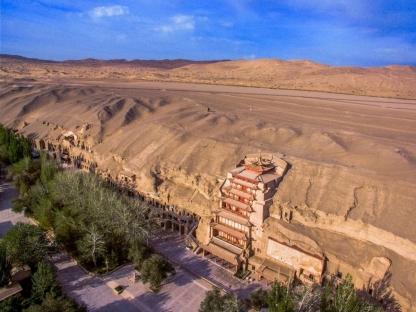 aerial view of Cave 96 and the surrounding area at the Mogao Caves near DunhuangCenturies later in the year 1900, the Taoist monk Wang Yuanlu who had settled down in the area rediscovered some of the caves which were largely obstructed by sand then. Starting with an expedition by the British archaeologist Aurel Stein in 1907, more and more of the caves were gradually rediscovered and explored. Unfortunately, the rediscovered caves also suffered some damage through theft and vandalism in the decades of exploration that followed. Since 1961, the caves are listed as a specially protected historical monument by China's State Council and preservation efforts are continuously ongoing at the site.
aerial view of Cave 96 and the surrounding area at the Mogao Caves near DunhuangCenturies later in the year 1900, the Taoist monk Wang Yuanlu who had settled down in the area rediscovered some of the caves which were largely obstructed by sand then. Starting with an expedition by the British archaeologist Aurel Stein in 1907, more and more of the caves were gradually rediscovered and explored. Unfortunately, the rediscovered caves also suffered some damage through theft and vandalism in the decades of exploration that followed. Since 1961, the caves are listed as a specially protected historical monument by China's State Council and preservation efforts are continuously ongoing at the site.
In order to preserve the caves and prevent further damage, the number of daily visitors is strictly controlled and limited to 6000 per day. On odd-numbered days in July and even-numbered days in August, an additional 12,000 tickets are available daily for a discounted price of 100 yuan each but these supplementary tickets only include the visit of four caves and the museums in front of the caves. It is therefore strongly advisable to reserve tickets in advance, especially during the peak season between May and October. However, only Chinese citizens will be able to reserve tickets online (up to 30 days in advance).
Foreign visitors could buy their tickets up to 30 days in advance at the Mogao Grottoes Reservation and Ticket Center in downtown Dunhuang (敦煌市迎宾花园北区15号楼102号 - No. 102, Building 15, North District of Yingbin Garden Community, East Yangguan Road) though. Additionally, tickets for a same-day visit can be bought at the Mogao Caves Digital Exhibition Center (敦煌市314省道9公里南侧,太阳温泉酒店向东500米 - 9km south of Provincial Road 314 in Dunhuang, 500m east of Sun Hot Spring Hotel). The official ticket offices at the entrance of the Mogao Grottoes also reserve a certain number of tickets for foreign visitors each day which are sold on a first-come, first-served basis. It is necessary to present a valid ID (which must be in the same name that the tickets are reserved in) to pick up the reserved tickets and foreign passports are accepted for this purpose.
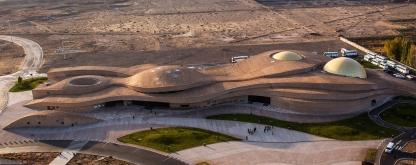 aerial view of the Mogao Caves Digital Exhibition CenterA visit of the Mogao Caves starts for most tourists at the abovementioned Digital Exhibition Center (which opens 30 minutes earlier than the cave area and closes at 3pm) which had been opened to the public in 2014. This futuristic-looking museum covers an area of 100,000 square meters and is located only about 2km away from the Dunhuang Railway Station and only 4km away from the Dunhuang Airport. The museum uses the latest in digital technology and multimedia tools to inform its visitors about Dunhuang's rich history and culture as well as the outstanding Buddhist art of the Mogao Caves. The two documentary films A Thousand Years of Mogao Caves (20 minutes - about the origin and development of the Mogao Caves) and The Splendor of Buddha's Palace (presenting the most outstanding caves in a large dome screen) are shown as well that should not be missed. After having finished their visit of the exhibition center, visitors can take a free shuttle bus from there directly to the caves. Alternatively, visitors could also take a public bus from outside the Dunhuang Hotel (8 yuan per person) at Dunhuang's center to the caves.
aerial view of the Mogao Caves Digital Exhibition CenterA visit of the Mogao Caves starts for most tourists at the abovementioned Digital Exhibition Center (which opens 30 minutes earlier than the cave area and closes at 3pm) which had been opened to the public in 2014. This futuristic-looking museum covers an area of 100,000 square meters and is located only about 2km away from the Dunhuang Railway Station and only 4km away from the Dunhuang Airport. The museum uses the latest in digital technology and multimedia tools to inform its visitors about Dunhuang's rich history and culture as well as the outstanding Buddhist art of the Mogao Caves. The two documentary films A Thousand Years of Mogao Caves (20 minutes - about the origin and development of the Mogao Caves) and The Splendor of Buddha's Palace (presenting the most outstanding caves in a large dome screen) are shown as well that should not be missed. After having finished their visit of the exhibition center, visitors can take a free shuttle bus from there directly to the caves. Alternatively, visitors could also take a public bus from outside the Dunhuang Hotel (8 yuan per person) at Dunhuang's center to the caves.
Just outside the cave area, you will find the Exhibition Center for the Conservation and Research of Dunhuang Cave Relics and there are three more museums inside the cave area as well. These are the Sutra Cave Exhibition Hall, Research Institute History Exhibition Hall and Research Institute Art Museum. A visit of all these museums is included in the admission price and it might be a good idea to visit them first before joining one of the guided tours of the caves.
40 Open Caves 2019
No.9, No.16, No.17, No.25, No.29, No.46, No.55, No.61, No.71, No.94, No.96, No.171, No.334, No.148, No.202, No.203, No.231, No.237, No.244, No.246, No.249, No.251, No.257, No.259, No.292, No.296, No.314, No.329, No.332, No.335, No.340, No.341, No.384, No.397, No.407, No.409, No.420, No.427, No.428, No.445
10 Special Caves (extra fees)
No.45, No.57, No.156, No.158, No.217, No.220, No.254, No.275, No.321, No.322
These 10 special caves may be visitable after paying an extra fee (per cave and person) during certain times of the year in addition to the 40 caves that are open regularly. Bring a flashlight!
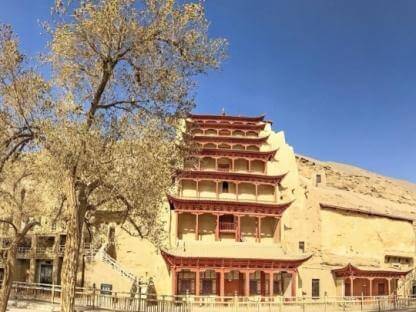 view of the temple facade outside Cave 96 of the Mogao Caves near DunhuangOf the surviving 735 caves, only a tiny fraction are open for visitors and it is not allowed to take photographs inside the caves in order to protect the murals. In the year 2019, only 40 different caves were open for tourist visits but only 7 - 8 different caves are usually shown by the tour guide during one accompanied visit. Tourists that want to see all 40 caves that are normally open would therefore have to visit them individually after the end of their guided tour. In addition to these 40 open caves, there are 10 more special caves that can be visited during certain parts of the year after paying an extra fee (for each special cave). Since these special caves are not illuminated, it is advisable to bring an electric flashlight when visiting them.
view of the temple facade outside Cave 96 of the Mogao Caves near DunhuangOf the surviving 735 caves, only a tiny fraction are open for visitors and it is not allowed to take photographs inside the caves in order to protect the murals. In the year 2019, only 40 different caves were open for tourist visits but only 7 - 8 different caves are usually shown by the tour guide during one accompanied visit. Tourists that want to see all 40 caves that are normally open would therefore have to visit them individually after the end of their guided tour. In addition to these 40 open caves, there are 10 more special caves that can be visited during certain parts of the year after paying an extra fee (for each special cave). Since these special caves are not illuminated, it is advisable to bring an electric flashlight when visiting them.
The caves that contain 2415 painted sculptures and whose walls are covered with about 45,000 square meters of murals are clustered together according to the era when they were built. In the murals, you'll find various depictions of all areas of life such as cultural exchanges along the ancient Silk Road (Cave 302), depictions of workers in the field (Cave 23) and warriors on a military campaign (Cave 156), portraits of individual donors and highly detailed images of artistic cartography (Cave 61). The largest sculpture you'll see at the site is a 35.5-meter tall Buddha that is housed inside Cave 96 behind the facade of a nine-storey temple. Other impressive Buddha statues can be found inside Tang dynasty Cave 148 (16-meter long sleeping Buddha) and special Cave 158 of the Tibetan era (15.6-meter long reclining Buddha).
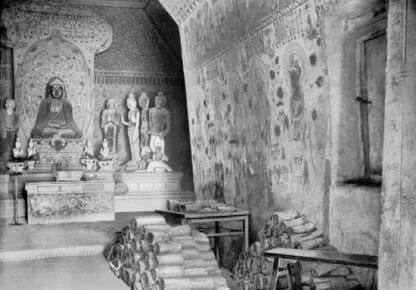 1907 photo showing piled-up manuscripts inside Cave 16 outside the door of the Library CaveOf all the surviving caves, it is arguably Cave 17 which is the most famous. This cave which has come to be known as the Library Cave was sealed off sometime early in the 11th century. When it was rediscovered and opened up by Wang Yuanlu in the year 1900, it contained a treasure trove of up to 50,000 manuscripts (dating from AD 406 - 1002) including around 1100 bundles of scrolls as well as more than 15,000 paper books and other texts. The Library Cave furthermore contained textiles such as banners as well as various kinds of Buddhist paraphernalia. Included among the discovered manuscripts was the Diamond Sutra from AD 868, the oldest known surviving and complete dated printed book. (A complete English translation of the Diamond Sutra is available online at this page for those interested.)
1907 photo showing piled-up manuscripts inside Cave 16 outside the door of the Library CaveOf all the surviving caves, it is arguably Cave 17 which is the most famous. This cave which has come to be known as the Library Cave was sealed off sometime early in the 11th century. When it was rediscovered and opened up by Wang Yuanlu in the year 1900, it contained a treasure trove of up to 50,000 manuscripts (dating from AD 406 - 1002) including around 1100 bundles of scrolls as well as more than 15,000 paper books and other texts. The Library Cave furthermore contained textiles such as banners as well as various kinds of Buddhist paraphernalia. Included among the discovered manuscripts was the Diamond Sutra from AD 868, the oldest known surviving and complete dated printed book. (A complete English translation of the Diamond Sutra is available online at this page for those interested.)
Due to the complexity of knowledge that is required to get the maximum benefit out of a personal visit of the Dunhuang Caves, potential visitors should consider doing some in-depth research online before going on the long journey to Dunhuang. Luckily, there is a plethora of information available online for free. The collaborative International Dunhuang Project (IDP) is an attempt to create a massive digital information and image repository of all the manuscripts, paintings, textiles etc. that were discovered at Dunhuang and other archaeological sites along the Eastern Silk Road. The Dunhuang Academy is a similar project with a website that is perhaps more tailored towards hobby historians than hardcore researchers. The Digital Dunhuang website even allows its users to visit accurate digital representations of 30 specific caves online. The Getty Research Institute went a step further and created 1:1 scale replicas of certain caves when it organized the exhibition Cave Temples of Dunhuang: Buddhist Art on China's Silk Road back in the year 2016. This popular exhibition even inspired the creation of new art which is a wonderful example how ancient art can inspire the human soul.
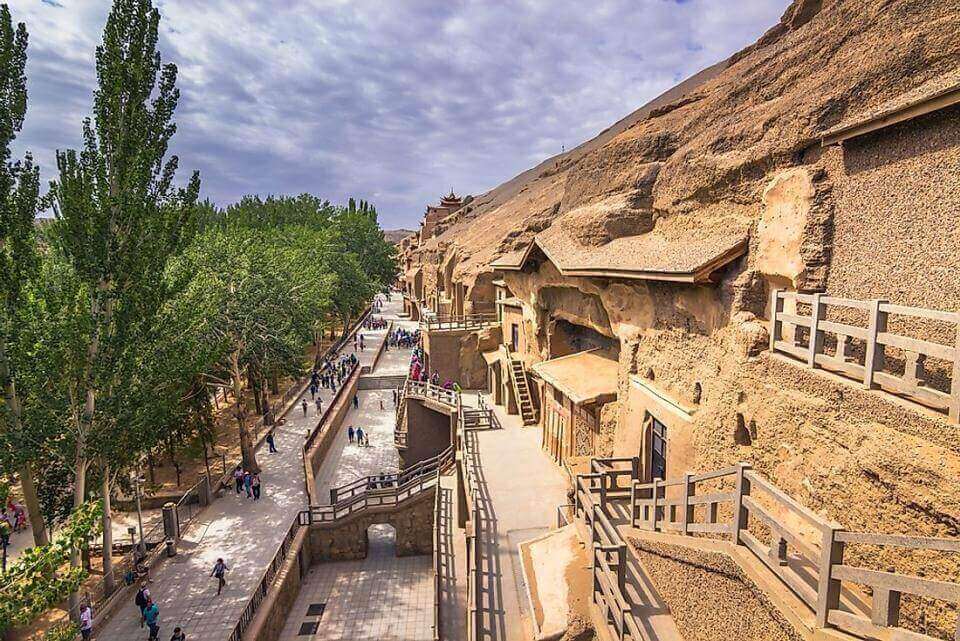 side view of the entrance areas of some caves and the pedestrian walkways that lead alongside the main cave area
side view of the entrance areas of some caves and the pedestrian walkways that lead alongside the main cave area
How to get to the Mogao Caves near Dunhuang?
| Address: | Mogao Caves (25km southeast of Dunhuang), Jiuquan district, Dunhuang, Gansu province, China |
| Tel.Nr.: | +86 937 886 9060 |
| Airport: | Dunhuang Airport (DNH) |
| Train Station: | Dunhuang Railway Station |
| Bus: | Tourists can take a public bus to the caves from outside the Silk Road Dunhuang Hotel, Dunhuang Hotel or the Dunhuang Railway Station |
On the following Google map, you can see the location of the Mogao Caves (the blue icon) and the Silk Road Dunhuang Hotel (the yellow hotel bed icon) which is our recommended hotel nearby. Further below on this page, you can read a review of this hotel's services and amenities. In case you are planning a trip to China, you could support this website by using the provided affiliate links to check prices and book your hotel accomodation!
You can book hotels in China with both of our affiliate partners Agoda and Trip.com. No matter whether you choose Agoda or Trip.com, you will find many offers on each of these platforms that will allow you to make a risk-free booking with the possibility of free cancellation until a clearly stated date and time, sometimes as late as on the intended date of arrival. However, some deals require prepayment and don't permit cancellation without fees. In that case, the incurred cancellation fees are clearly stated.
When following an Agoda link, the search results will show you prices, availability and special offers for your chosen dates with the recommended hotel in the top search position as well as for other hotels in the same area. Links to Trip.com will take you to the specific hotel webpage where you can then search for availability, prices and special deals with your chosen dates.
The provided information was thoroughly researched from various hotel booking websites. Chinese History Digest is not responsible if any information regarding the provided services and amenities might have changed.
Recommended Hotel near Dunhuang's Mogao Grottoes
There is no hotel right next to the Mogao Grottoes which are located at a remote spot in the desert. From the Silk Road Dunhuang Hotel that is reviewed below, guests can conveniently reach both the city center and the caves. In addition to the links to Agoda that are used in the review below, this hotel is also available for booking on Trip.com by following this link.
Silk Road Dunhuang Hotel
 The Silk Road Dunhuang Hotel is officially a 3-star hotel though it provides many 4-star-level services and amenities. What makes this hotel truly exceptional is not only its unique architectural style but especially its outstanding location overlooking the Mingsha Sand Dunes. There is probably no better place to find out what staying at an oasis in the desert feels like, for example when watching the sun rise or set over the sand dunes from the hotel's rooftop café and bar. What's more, the Silk Road Dunhuang Hotel is neither too far away from Dunhuang's city center (about 3km) nor its airport (about a 20-minute drive). Free airport pickup is provided, guests just have to inform the hotel of their flight number when/after booking their room. The hotel also operates a free shuttle service to Dunhuang's night market. The Mogao Grottoes are a 30-minute drive away and the hotel can organize car rentals as well as taxi bookings. There are also public busses that go to the caves and stop at the hotel on the way.
The Silk Road Dunhuang Hotel is officially a 3-star hotel though it provides many 4-star-level services and amenities. What makes this hotel truly exceptional is not only its unique architectural style but especially its outstanding location overlooking the Mingsha Sand Dunes. There is probably no better place to find out what staying at an oasis in the desert feels like, for example when watching the sun rise or set over the sand dunes from the hotel's rooftop café and bar. What's more, the Silk Road Dunhuang Hotel is neither too far away from Dunhuang's city center (about 3km) nor its airport (about a 20-minute drive). Free airport pickup is provided, guests just have to inform the hotel of their flight number when/after booking their room. The hotel also operates a free shuttle service to Dunhuang's night market. The Mogao Grottoes are a 30-minute drive away and the hotel can organize car rentals as well as taxi bookings. There are also public busses that go to the caves and stop at the hotel on the way.
Rooms at the Silk Road Dunhuang Hotel provide both heating and air-conditioning. Non-smoking rooms can be requested. Free internet access is available through Wi-Fi and LAN cable. All rooms are equipped with a refrigerator, flatscreen satellite TV, safe box and a minibar. Laundry service (including dry cleaning) and luggage storage are available. Room service is available 24/7 and free bottled water is provided. In addition to free breakfast, guests have plenty of choices where to eat at the Silk Road Dunhuang Hotel. There are five restaurants on the premises and several more in the hotel's vicinity. For exercise, the hotel has a fitness center, table tennis room, billiards room and basketball court. For leisure, guests can relax at the hotel's garden, go to the sauna and/or steamroom or book a massage.
8.6 miles away
Check availability & prices!